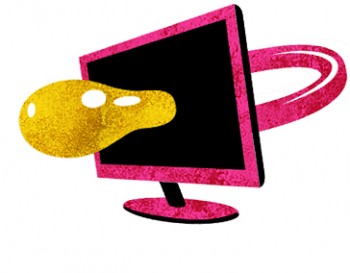Kidult culture
4 April 2012 | Non-fiction, Tales of a journalist

Illustration: Joonas Väänänen
Life is hard, and then you grow up. Except that you don’t really, at least if you keep watching television. Jyrki Lehtola takes a look at entertainment for the Peter Pan generation – which, he argues, is pretty much all of us
When did we start making television for children? I mean, in theory for adults (believe me, advertises, believe me: for adults!) but in practice for children?
Theoretically television is a wonderful, flexible medium less dependent on big money than the film business. Why did we let it slip out of our hands as a form of expression?
Why did we start making adult programmes for children and children’s programmes for adults? In other words, why do we make exactly the same TV programmes for everyone?
As always, everything was naturally better in the past. Before dinner there were ‘kids programmes’ for children to watch. In Finland they were usually Eastern European cartoons, but in other places they were American ones. In these shows good was good and bad was bad, but only temporarily, because in the end the bad guy always got to sit down with the good guy and eat a carrot too, since he had learned it was better to be good than bad.
Then something changed. Adults no longer grew up to be adults. Apparently life became so hectic that it demanded all the energy they had to give, so after work they had no desire to use their brains or concentrate on anything.
So we started making slightly easier TV programming for them. Dramas consisting entirely of stereotypes; dramas depicting a time when everything was straightforward and life was a little slower; cartoons for adults, with humor children can also understand; competitions where someone sings and the audience can vote whether he or she is singing well; reality TV where a pack of unpleasant people are shoved in a locked cage or dropped off in a jungle and then we watch to see how much more unpleasantness can be extracted from them.
This we watched, wine glasses in hand, and called it relaxation. Soon our teenage children joined us on the sofa, because these series were also their favorite series, and isn’t it nice when the whole family can spend time together?
And when the TV studios woke up to the fact that teenagers were watching the adult shows too, they made them even more simplistic; the teenagers’ younger siblings, the 6-10-year-olds, now also appeared on the sofa to watch excitedly to see who would be dancing with whom and whether someone could really eat a pile of worms like that just for money and, ‘Yuk, what are those two drunk teenagers doing? Oh, they’re kissing – gag me with a spoon.’
So there we were. A family who had become a single target audience. Of course there still were separate programmes for adults (boring talk shows and series produced by the likes of HBO and Showtime) and children’s shows, but most TV content was programmes ‘for the entire family’, from soap operas to the Simpsons.
When the TV channels realised this, they also realised that they couldn’t let the shows be a danger to children. And they were.
They had swearwords, off-colour jokes, obscene gestures. They came on at a time when there could potentially still be some child awake somewhere. So questionable references had to be removed and the language had to be watered down, because the most important thing in protecting our children is that we look like we’re protecting our children.
Television could matter. It is in every home, either in its traditional form or delivered and viewed through computers. But instead of taking advantage of its potential, we make programmes for children.
We could condescendingly deride the state of television by wondering why we make the same programming for adults and children even though we don’t write books as if the two target audiences were the same.
Except that we do. Because we adults don’t have the energy or patience for reading, we read books directed at children and the feebleminded: Harry Potter, pre-underlined diet and self-help books, and books with the words ‘da Vinci’ or ‘code’ in the title to reassure us that we also have what it takes for more challenging reading.
Magazines are mostly made so children can also understand the world view they present, which is generally connected to the ideas that suffering builds character and every dog has its day.
The Finnish press holds a ‘newspaper week’ each year during which the content of the papers is adjusted to appeal more to schoolchildren. Unfortunately the difference compared to normal editions is embarrassingly small, if any exists at all.
Popular music is made for children and all of us who want to feel like we are still young. In films young people go on adventures in imaginary worlds, fart as a sign of humour and ruminate over interpersonal problems that the children sitting in the audience have already solved.
The visual arts have always been an art form that ‘my niece’ could produce, and in the theatre we are taught that if any feeling exists, it can be dressed up in the form of a song either melancholy or cheerful.
Before we had target audiences for which we produced content. Ill-tempered and kindly grandparents, tired and energetic adults, normal and alternative youth, the cultured and the uncultured, those interested in the world and those looking for entertainment.
Now we just have two target groups: children and the ever-shrinking group of adults who would occasionally like something besides culture for kids.
Translated by Owen Witesman
Tags: media, television
No comments for this entry yet
